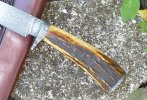- Joined
- Nov 23, 2013
- Messages
- 306
Several months ago, I made my first small billet of damascus from 1084 and 15N20. I should have known better, as I really am not ready or skilled enough to pull it off successfully yet. Anyway, I finished forging it out the other day, and managed to salvage a piece off it that was large enough to make a "S" guard for a blade I'm working on. Problem is, when I attempted to etch it (just a trial to see the pattern, its not fully shaped and polished yet), the 15N20 has very little contrast to the 1084. I could easily see the different layers, but they were roughly the same color. I etched in hot vinegar, and the piece is unhardened.
Do I need to harden it to get the contrast? How fine should I sand it prior to etching? Is scotchbrite too aggressive for cleaning the oxides off? What is your method for bringing out the pattern in damascus?
Do I need to harden it to get the contrast? How fine should I sand it prior to etching? Is scotchbrite too aggressive for cleaning the oxides off? What is your method for bringing out the pattern in damascus?









